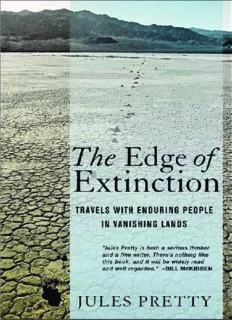
The Edge of Extinction: Travels with Enduring People in Vanishing Lands PDF
Preview The Edge of Extinction: Travels with Enduring People in Vanishing Lands
THE EDGE OF EXTINCTION Th e Edge of Extinction TRAVELS WITH ENDURING PEOPLE IN VANISHING LANDS M j u le s pr ett y Comstock Publishing Associates a division of Cornell University Press Ithaca and London Copyright © 2014 by Cornell University A ll rights reserved. Except for brief quotations in a review, this book, or parts thereof, must not be reproduced in any form without permission in writing from the publisher. For information, address Cornell University Press, Sage House, 512 East State Street, Ithaca, New York 14850. First published 2014 by Cornell University Press Printed in the United States of America Library of Congress Cataloging-in-Publication Data Pretty, Jules N., author. Th e Edge of extinction : travels with enduring people in vanishing lands / Jules Pretty. pages cm Includes bibliographical references. ISBN 978-0-8014-5330-4 (cloth : alk. paper) 1. Nature—Eff ect of human beings on—Moral and ethical aspects. 2. Human beings—Eff ect of environment on—Moral and ethical aspects. I. Title. GF80.P73 2014 304.2—dc23 2014017464 Cornell University Press strives to use environmentally responsible suppliers and materials to the fullest extent possible in the publishing of its books. Such materials include vegetable-based, low-VOC inks and acid-free papers that are recycled, totally chlorine-free, or partly composed of nonwood fi bers. For further information, visit our website at www.cornellpress.cornell.edu . Cloth printing 10 9 8 7 6 5 4 3 2 1 { iv } For My father, John Pretty (1932–2012), and mother, Susan and Gill, Freya, and Th eo Without my journey And without this spring I would have missed this dawn. —Masaoka Shiki (1856–1902) Traveling this high Mountain trail, delighted By violets. —Matsuo Bashō (1644–94) { v } CONTENTS Previously ix Note on Weights and Measures xiii 1. Seacoast: Ngāi Tahu, Aotearoa (New Zealand) 1 2. Mountain: Huangshan, China 13 3. Desert Coast: Murujuga (Burrup), Australia 25 4. Steppe: Tuva, Russia 37 5. Snow: Karelia, Finland 55 6. Swamp: Okavango, Botswana 71 7. Marsh-Farm: East Anglia, England 85 8. Coast: Antrim Glens, Northern Ireland 103 9. Snow: Nitassinan, Labrador, Canada 121 1 0. F arm-City: Amish Country, Ohio, United States 139 11. Swamp: Atchafalaya Basin, Louisiana, United States 155 12. Desert: Timbisha (Death Valley), California, United States 177 Coda: Dreaming of the Day Aft er 199 Notes 201 Bibliography 207 Acknowledgments 219 { vii } PREVIOUSLY I oft en rise before dawn and sit on the pine bench in the garden. In winter’s cold, plumes of breath greet fi rst light. All is silent. In spring, the liquid songs of robins and blackbirds welcome the sun. In summer come swarms of midges, then at dusk bats stitch in and out of shadows. I water the plants, fi ll the bird feeders. In autumn if I am still, deer come, delicately stepping beneath the apple trees. Above may cir- cle buzzards on thermals, lately come to the valley, and jackdaws and rooks daily beat with purpose toward the east, tumbling playfully back at dusk. Th e garden is nothing special. Wild and not wild. Nothing stays the same. It is droughty, then sodden. Sheets of drizzle, then sun. Blankets of snow. Clear cold nights bringing a family of tawny owls. Th en in spring, nightingales singing from the same trees. Animals come and go; plants sprout, grow, are swamped, die back. Yet how is the economy to recover if we were all so irresponsible? Seriously, how can it survive if we sit around and do not spend more? Th e notion of the inevitable benefi ts of all material progress is a modern inven- tion. Hunters and foragers, many farmers and herders too, tend not to hold that their current community is any better than those of the past or at other places. Past and future are no more or less valued than current time. But economic devel- opment too easily justifi es the losses of both species and special places, as we expect losses to be off set by creating something much better. Our environmental problems are thus human problems. Disconnection from the land, in the form of non-regular contact, already has the capacity to damage and even destroy cultures. Yet many talk of the need for escape, to get away from it all. Something important remains elusive to many moderns. It is much happi- ness. We do not have clear answers, but the proportion of people in industrial- ized countries describing themselves as happy has not changed since the 1950s, despite a trebling of wealth. At the same time, the incidence of mental ill-health has grown rapidly. We solved, largely, infectious diseases; then came cancers. Our lives were extended and treatments improved; then came obesity, and problems of cardiovascular disease and diabetes. Dementias have become more common { ix }
Description: